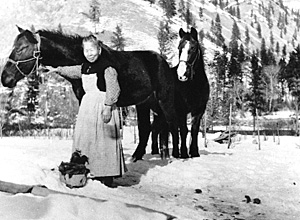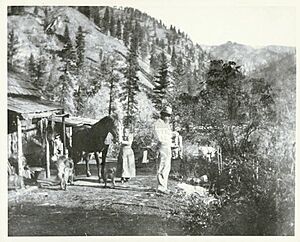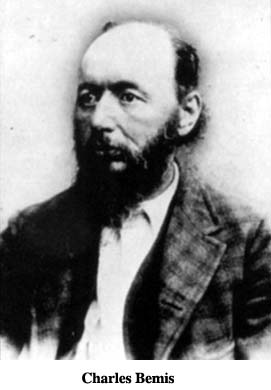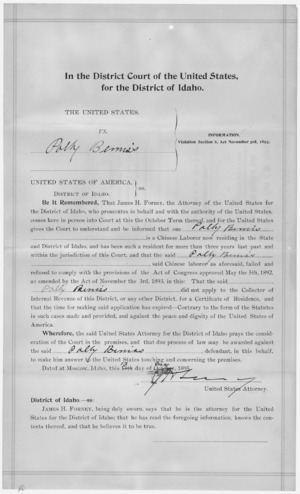Polly Bemis facts for kids
Quick facts for kids
Polly Bemis
|
|
|---|---|
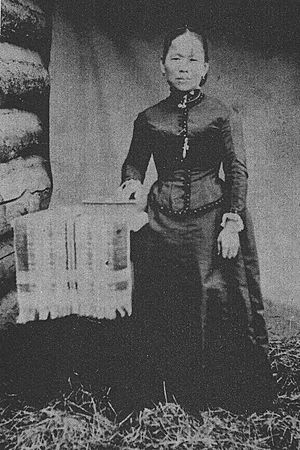
Polly Bemis wearing her wedding dress in 1894.
|
|
| Born | 11 September 1853 |
| Died | 6 November 1933 (aged 80) Idaho, US
|
| Resting place | Polly Bemis House, Idaho |
| Nationality | American |
| Other names | Lalu Nathoy |
| Occupation | Rancher |
| Spouse(s) | Charlie Bemis (m. 1894; died 1922) |
Polly Bemis (born September 11, 1853 – died November 6, 1933) was a Chinese American pioneer. She lived in Idaho during the late 1800s and early 1900s. Her life story became a biographical novel. It was also featured in the 1991 movie Thousand Pieces of Gold.
| Top - 0-9 A B C D E F G H I J K L M N O P Q R S T U V W X Y Z |
Polly Bemis's Early Life
Polly Bemis was born on September 11, 1853. Her family lived in a small village in northern China. As a child, Polly had bound feet, a practice that was later undone. When she was eighteen, a long drought hit her village. Her father sold her to a group of bandits for two bags of seeds. These seeds were desperately needed by her family.
In 1872, Polly was brought to the United States. She was sold in San Francisco, California. An agent then took her from San Francisco to Idaho. Her buyer was a wealthy Chinese man. He ran a saloon in a mining camp. This camp was in Warrens, Idaho Territory, now called Warren, Idaho. Polly arrived in Warrens on July 8, 1872. She was about 53 inches (130 cm) tall.
It is not fully clear how Polly gained her freedom. Some historians believe her Chinese owner helped her. By mid-1880, census records show her living with Charlie Bemis. Charlie (1848–1922) was a saloon owner and fiddler. He had befriended Polly when she first arrived in Warrens. He also protected her from unwanted attention. Charlie was known for being brave and good with a gun. This helped him keep peace without getting into trouble. Polly often sought Charlie's help when things were difficult.
Polly's Work and Skills
Polly Bemis was not financially dependent on Charlie Bemis. She earned her own money. Polly took in laundry from miners. She also ran a boarding house that Charlie built for her. It was located near his saloon.
Polly had many useful skills. In September 1890, Charlie was shot during a dispute. Polly nursed him back to health. She was also an expert at angler fishing in the Salmon River.
Polly's Personal Life
On August 13, 1894, Polly married Charlie Bemis. They moved from Warren to a new home. This spot was 17 miles north by trail. It became known as Bemis Point or Polly Place. A friend, Peter Klinkhammer, said their marriage was practical. Polly needed to become a legal resident in the U.S. Charlie needed someone to care for him.
Polly worked hard to become a legal resident. Her case went to court in Moscow, Idaho. She finally gained her residency on August 10, 1896. This happened in Helena, Montana. Together, Charlie and Polly Bemis claimed a mining spot. They were among the first pioneers to settle along the Salmon River. This river is also known as The River of No Return. Their house was only a few yards from the river. Even today, this house cannot be reached by road. Boats are the main way to get there.
Polly and Charlie did not have children. Polly was 40 when they married. However, she was known for caring deeply about children. They also enjoyed gardening. They looked after many animals. These included horses and a cougar. Polly was also known for her nursing skills. She was friendly, witty, and had a good sense of humor.
Polly saved Charlie's life a second time. In the summer of 1922, a fire destroyed their home. It might have been caused by an overheated woodstove. Charlie was inside the house. Polly, along with their friend Shepp, rescued him. The Bemises then moved across the Salmon River. They lived with their friends and neighbors, Peter Klinkhammer and Charlie Shepp.
In late October 1922, Charlie Bemis passed away. He had been sick for several years.
Klinkhammer and Shepp built a new home for Polly. It was on the same spot as the burned house. They agreed to inherit the house from her. In return, they would care for her in her old age. While the house was being built, Polly moved to Warren. She visited Boise, Idaho. There, she saw her first movie. She also rode her first streetcar and elevator. Polly gave a photo of herself in her wedding dress to a young schoolgirl named Gay Carrey. Gay boarded with Polly during the school year. In 1924, Polly moved back to her completed cabin on the Salmon River.
On August 4, 1933, Shepp visited Polly. He found her lying on the ground. She was confused and unable to move. This may have been due to a stroke. On August 6, she was taken to Grangeville, Idaho. She stayed in the Idaho Valley Hospital for three months. During her hospital stay, she talked a lot about her life. On November 5, a long newspaper article was published about her.
Polly Bemis died on November 6, 1933. She was 80 years old. She passed away from a heart condition in Grangeville, Idaho. Two days later, Polly was buried in Grangeville. After Klinkhammer died in 1970, his sister bought a marker for Polly's grave.
Polly Bemis's Legacy
In 1987, Polly's cabin, known as Polly Bemis House, was restored. Polly's body was reburied on the grounds near the cabin. The cabin is located 17 miles north of Warren, Idaho. It became a museum. In 1988, it was added to the National Register of Historic Places.
In 1987, a special ceremony was held. Idaho Governor Cecil Andrus spoke at the event. He said, "The history of Polly Bemis is a great part of the legacy of central Idaho. She is the foremost pioneer on the rugged Salmon River." Polly Bemis was honored in the Idaho Hall of Fame in 1996.
Polly Bemis is featured in a series of paintings. These are called Chinese in Idaho. They were created by Chinese-American artist Hung Liu. The University of Idaho has called her "Idaho's most famous Chinese woman." They even offered an anthropology course about her life. It was called "The World of Polly Bemis."
Debates About Polly's Life
Historians still discuss the details of Polly Bemis's life. For example, there is little proof that she was ever called "Lalu." Also, it's not certain that "Hong King" was truly her owner's name. Some sources suggest she was an indentured dance hostess. As she neared death, Polly denied a popular story. This story claimed she was "won in a poker game."
According to author Ruthanne Lum McCunn's research, Charlie married Polly for a specific reason. He wanted to prevent her from being sent out of the country. This was due to the 1892 Geary Act. This law required Chinese residents to carry a special certificate. Polly did not have one. Even though Idaho had laws against mixed-race marriages, the Bemises were married by a white judge. This judge was married to a Native American woman.
Books and Films About Polly
- A biography was written in the 1970s. It is called Idaho County's Most Romantic Character: Polly Bemis. It was written by Sister M Alfreda Elsensohn.
- Thousand Pieces of Gold is a historical novel from 1981. It is about Lalu Nathoy, or Polly Bemis. The author, Ruthanne Lum McCunn, included an essay. It explains her research for the book. This novel was made into a 1991 film. It was also called Thousand Pieces of Gold. Rosalind Chao played Polly, and Chris Cooper played Charlie.
- Polly Bemis: A Chinese American Pioneer was written by Priscilla Wegars. It was published in 2003. This is a well-known history book for elementary classrooms.
- The Poker Bride: The First Chinese in the Wild West was written by Christopher Corbett (2010).
- Wild Women of the Old West includes sections about Polly. It was edited by Glenda Riley and Richard W. Etulain (2003).


